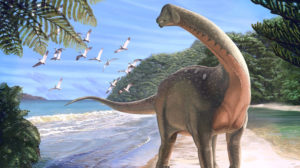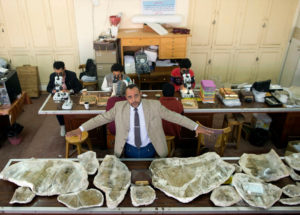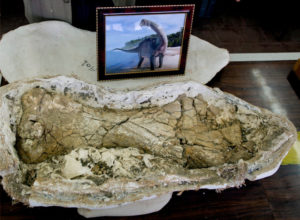Mansourasaurus shahinae is the only dinosaur from the Late Cretaceous ever found in Africa

A skeleton has been unearthed in Egypt’s Western Desert, whose ancient sands have long helped preserve remains, but unlike most finds this one isn’t a mummy — it’s a dinosaur.
Researchers from Mansoura University in the country’s Nile Delta discovered the new species of long-necked herbivore, which is around the size of a city bus, and it could be just the tip of the sand dune for other desert dinosaur discoveries.
“As in any ecosystem, if we went to the jungle we’ll find a lion and a giraffe. So we found the giraffe, where’s the lion?” said Hesham Sallam, leader of the excavation team and head of the university’s Center for Vertebrate Paleontology.

Sallam, along with four Egyptian and five American researchers, authored an article in the journal Nature Ecology and Evolution published Jan. 29 announcing the discovery.
Experts say the find is a landmark one that could shed light on a particularly obscure period of history for the African continent, roughly the 30 million years before dinosaurs went extinct, between 70 and 80 million years ago.
Named Mansourasaurus Shahinae after the team’s university and for one of the paleontology department’s founders, the find is the only dinosaur from that period to have been discovered in Africa, and it may even be an undiscovered genus.

In the article the authors say the team’s findings “counter hypotheses that dinosaur faunas of the African mainland were completely isolated” during the late Mesozoic period. That is, previous theories were that Africa’s dinosaurs during that time existed as if on an island and developed independently from their northern cousins.
Like European fossils
But Mansourasaurus’ fossilized skeletal remains suggest an anatomy not very different from those discovered in Europe from the same period, an indication that a land connection between Africa and its northern neighbour may have existed.
While Egypt has a long history of archeology, paleontology has not enjoyed the same popularity — or had the same success.
In 1911, the German paleontologist Ernst Stromer led an expedition to the oasis of Bahriya, also in Egypt’s Western Desert. There, he discovered four species of dinosaurs, including a predatory type known as the Spinosaurus, all from the Cretaceous period. But all of his findings were later lost in Allied bombing of the Munich Museum during World War II.
Sallam said researchers don’t know how Mansourasaurus lived and died, except for the fact that it was a plant eater. There’s no indication whether it lived alone or in a herd.
The bones do bear resemblance to another dinosaur discovery in Egypt, that of the Paralititan stromeri, excavated by an American team from the University of Pennsylvania, whose findings were published in 2001. But only in so much as both were long-necked herbivores grazers. The Paralititan stromeri is believed to have been among the largest known animals, weighing in at 68 tonnes and over 30 metres (33 yards) long.
The Mansourasaurus’ smaller size is more typical of the Mesozoic era, when dinosaurs’ time was running out, geologically speaking, according to Sallam. With a long neck and tail, his torso would’ve been similar to that of an African elephant and measuring tip-to-tail over 10 metres (11 yards) and weighing several tonnes.
Coastal jungle
Egypt’s Western Desert would have more closely resembled a coastal jungle during the dinosaur’s lifetime, with half of what is the country today under water.
Though finding a dinosaur bone in a vast desert may seem akin to a needle in a haystack, it was also the product of back-breaking work. The team had been scouring the area of the find more than 750 kilometres (466 miles) southwest of the capital for five years before they found the partial skeleton of the Mansourasaurus in 2013.

Sallam said he and a group of doctoral and master’s degree students were heading to give a lecture at a local university when they stumbled on a desert road with the appropriate geological outcroppings that they hadn’t noticed before. The next morning, the team returned to survey it, covering an area of several kilometers. It wasn’t long after they started that one of the students called him on the phone, saying that he should come see the number of bones she’d found.
Sallam said he knew from the first small piece of fossil he was shown that it was a big deal.
“When I first saw it I told them, if this comes out as I expect, your names will go down in history,” he told his students.
There is now some hope the discovery could bring more funding for the paleontology field in Egypt and financing for ongoing studies, Sallam said. But he said he’s most proud of making science real for people who otherwise aren’t exposed to it as much.
“I mean, we’ve made the average Egyptian man, or the Arab man, talk about dinosaurs,” he said.


